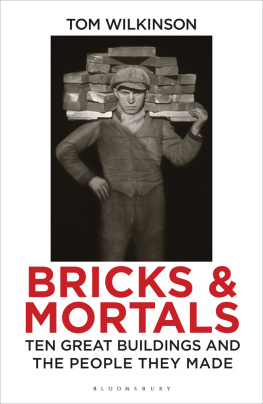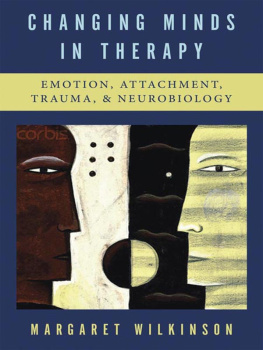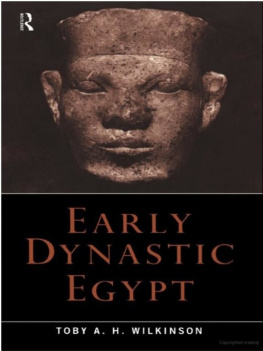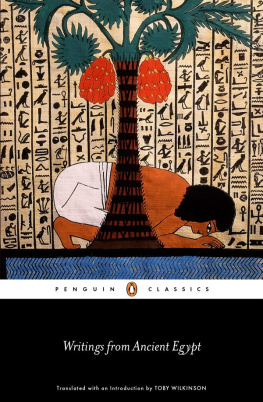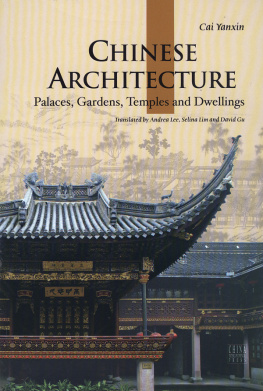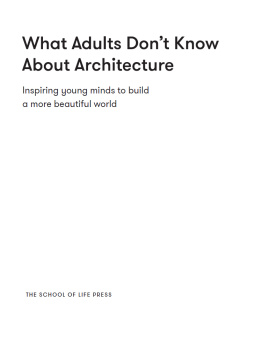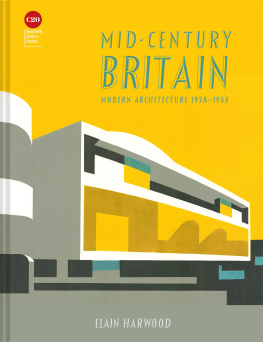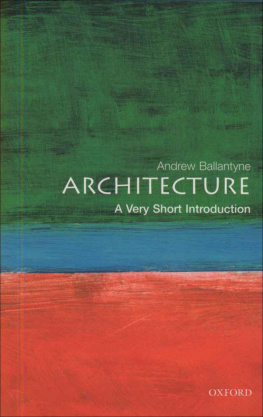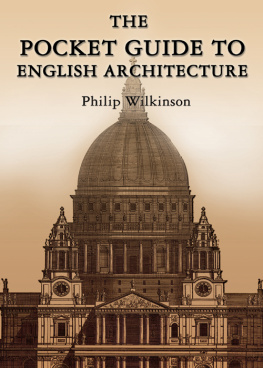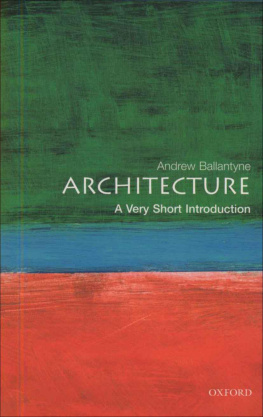The idea of writing this book would never have occurred to me without the prompting of Isabel Wilkinson, and it wouldnt have got much further than an idea without the encouragement (and irresistible charm) of Rachel Mills, Annabel Merullo and Tim Binding at Peters Fraser and Dunlop. At Bloomsbury, I thank Richard Atkinson for commissioning the book, and Bill Swainson, whose enthusiasm and expertise helped me over the finishing line. I must also express my gratitude to Professor Fred Schwartz at University College London, for his patience and support while I dodged my academic responsibilities, and for the rigorous example set by his own work; I can only hope that I have not sunk too far below his standard here. Buyun Chen kindly put me up in New York and offered her expert advice on the Garden of Perfect Brightness (any errors remaining in that chapter are of course my own), and Steve and Helen Baker assisted with translating Cline. My colleagues at the Architectural Review have also helped me in innumerable ways; and I must thank the Fiells for pointing me in their direction. Finally, I would like to thank Abi Wilkinson and Nathalie Zdrojewski for helping me through an occasionally trying couple of years, Owen Kyffin for his invaluable advice, and the man from Hostel Detroit who drove me to the Rouge.

August Sander, Bricklayer (1928)
Tom Wilkinson is History Editor of the Architectural Review . He is writing a doctoral thesis on art history at University College London, where he has taught an undergraduate course on architectural history. He has lived in Shanghai and Berlin, and currently lives in East London.
( c .650 BC )
Architecture and Power
And Babylon shall become heaps, a dwelling-place for dragons, an astonishment, and a hissing, without an inhabitant.
Jeremiah 51:37
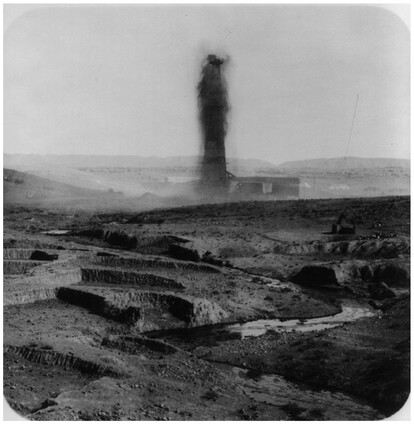
An oil gusher at Baba Gurgur oilfield in Iraq, formerly Babylon ( c .1932). In the foreground a river of oil flows through the desert
When British forces entered Baghdad in March 1917, so securing the crucial oilfields of the former Ottoman empire, German archaeologist Robert Koldewey was forced to abandon one of the most fabulous discoveries of the twentieth century: the ancient city of Babylon. Since 1898 Koldewey had been digging in Mesopotamia (present-day Iraq), the fertile land between rivers where Babylon once stood, and where archaeologists tell us that writing, architecture, and the city were invented. He had already shipped the magnificent Ishtar Gate back to Berlin and was now excavating the Hanging Gardens (or so he thought: his identification of those particular remains turned out to be wrong).
One of his most intriguing finds, admittedly not much to look at compared with the glistening blue tiles of the Ishtar Gate, was a rectangular pit filled with stagnant water. But this pit revealed the foundations of a building that had for millennia existed only in legends: the Tower of Babel. Called by its Babylonian builders Etemenanki House of the Foundation of Heaven and the Underworld the tower was an enormous ziggurat or step pyramid with a temple on its summit consecrated to the god Marduk, the fearsomely bearded creator of mankind and patron deity of Babylon. But although Babylon and its gods were wiped off the map centuries before the birth of Christ, the Tower of Babel has lived on for over two thousand years, haunting our imaginations in paintings, legends, wars and revolutions. A potent double image, it stands for the power of architecture over people, and vice-versa. Depending on the way you read the story of Babel, its tower either oppressed the people forced to build it, or it was liberating, bringing its makers together in a common endeavour of self-empowerment.
These twin towers positive and negative images of the same building face off like two mirrors creating an infinite echo of receding towers. Babel, Bastille, World Trade Center . . . Monumental structures like the Tower of Babel have been built since the dawn of history. They are very obvious manifestations of architectural power, as are prisons, palaces, parliaments and schools, but even architecture built by ordinary people whether houses or garden sheds expresses and perpetuates power relations in everyday life. This theme comes up again and again in the story of bricks and mortals, but the present chapter is a tale of grandiose structures, and the fight against them whether in Paris, New York or Baghdad, where the ruins of the Tower of Babel sit on one of the biggest oilfields in the world. There is no greater power in the world today than oil, and its story is intimately entwined with that of architecture. Telling it will take us through some unexpected twists and turns. Brecht wrote that petroleum resists depiction in five acts: todays catastrophes do not unfold in linear fashion, but in cycles of crises in which each fungible hero changes with the individual phases; likewise, the story of the Tower of Babel has many protagonists hijackers, archaeologist-spies, iconoclasts and kings. So lets drill down through the layers of history back through the invasion of Iraq, 9/11, the world wars, the rediscovery of the Tower of Babel, the search for oil in the Middle East and beyond, to the beginning of scriptural time.
The most familiar account of the Tower of Babel appears in the Bible. According to the author of the Book of Genesis, the people of the world (who were united at the dawn of history) decided to build a tower, whose top may reach unto heaven in order to make a name, lest we be scattered.
In this succinct tale the Bible illustrates both the utopian aspirations of builders and the ultimate limit of architectures possibilities. It is usually read as a warning against hubris, for example by Flavius Josephus, a Romanised Jew of the first century. He misidentified the leader of Babylon as Nimrod, great-grandson of Noah, a tyrannical monarch who convinced the people that they didnt need God because it was within their own power to be happy. He also said he would be revenged on God, if he should have a mind to drown the world again; for that he would build a tower too high for the waters to be able to reach! And that he would avenge himself on God for destroying their forefathers! This reading ingeniously provides a motive for the builders, but if you look more closely at the biblical tale, the text doesnt explicitly say that hubris is their crime. Despite the apparent simplicity of the tale, there is a deep ambiguity at play: depending on the way you see it, either the builders of the tower or the vengeful deity are working for the benefit of mankind. From the former perspective, the tower is an expression of the unity of humanity, and God stops it because he jealously refuses to accept any challenge to his power. Alternatively, you could say that God freed mankind from the implied tyranny of the Babylonian monarch, and the unity he enforced in order to build a massive and pointless vanity project. Its an ambiguity that recurs throughout the history of architecture: buildings have great potential as a means of empowering people, but they can also enslave them. Sometimes these two forces are united in one structure.
The Tower of Babel isnt just an enormous allegory; there is also a core of historical truth to the story. Indeed, the Jews were much more closely acquainted with the city of Babylon than they might have liked. Many of them spent fifty years there during the Babylonian Captivity, which followed an unsuccessful uprising against their imperial master King Nebuchadnezzar II. Ruler of a recently resurgent empire, Nebuchadnezzar had spent years restoring his capital to the glory of its early days with a little help from his army of slaves. Building was a way of controlling an intensely hierarchical society, and like the Pyramids, the Great Wall of China (in the construction of which an estimated million workers died) or Stalins White Sea Canal, Nebuchadnezzars works were completed by captives, making life for the builders bitter with hard bondage, in mortar, and in brick as the Jews later found in Egypt.
Next page
